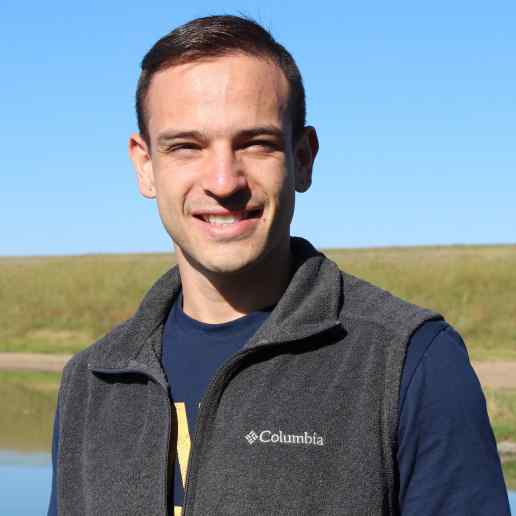
Robbi Bishop-Taylor
PhD Student
Email: r.bishop-taylor@unsw.edu.auOffice address:
Room 642, D26 Building UNSW, Kensington 2052
Primary supervisor: Mirela G TulbureJoint supervisor: Mark Broich
Research title: Surface water networks in the Murray-Darling Basin: a graph theory approach
Field of Research:
Spatiotemporal analysis, landscape ecology, GIS, ecological connectivity, graph theory, network analysis, geography
Biography:
As a result of his PhD work Robbi got a continuing job with Geoscience Australia's earth observation team.
As an aspiring spatial and environmental scientist, I have a keen interest in the natural world and believe strongly in the role landscape-scale research has to play in maintaining the viability of ecosystems increasingly impacted by development and environmental change. I am particularly interested in how dynamic remote sensing datasets and network analysis can be used to study landscape connectivity through time and across large spatial extents, potentially providing a powerful and efficient mechanism for prioritising conservation within highly modified and increasingly contested landscapes.
Research
Current work
Robbi's research focuses on modelling ecological connectivity between surface water habitats of the Murray-Darling Basin, one of the largest semi-arid agricultural basins in the world (> 1 million km2) and home to many of Australia's most significant freshwater ecosystems. Robbi uses graph theory network modelling to analyse connectivity, an advanced statistical framework which has recently seen a rapid uptake for analysing connectivity in terrestrial, marine and surface water systems. By combining graph theory modelling with over 25 years of newly available high-resolution remotely sensed surface-water datasets, this work will attempt to characterise spatiotemporal connectivity dynamics across the Murray-Darling at seasonal, yearly and decadal scales. It is anticipated the results of this research will contribute to current understanding of how habitat network structure, landscape conditions and dynamic events such as flooding combine to influence connectivity across space and time, and ultimately assist in prioritising critical surface water habitats for conservation (e.g. Figure 1).


Former work
From 2011 to 2013, Robbi worked collaboratively with an international team of environmental scientists, GIS specialists and landscape archaeologists on the Tundzha Regional Archaeological Project. He helped to design and conduct a multi-disciplinary geoarchaeological project involving extensive field work aimed at studying the paleoenvironmental landscape of an archaeologically significant region of central Bulgaria. During his Honours year, datasets collected in Bulgaria were analysed to model the socio-ecological consequences of past human habitation at varying temporal and spatial scales, and explore the dynamic and synergistic effects of climate change and agricultural intensification on historic land use patterns.

Scholarships:
- NASA-MSU Professional Enhancement Award (Scholarship to attend World Congress of the International Association for Landscape Ecology)
- Outstanding Graphic Award, 2016 Research Excellence Awards (Evolution and Ecology Research Centre)
- Runner up, Outstanding Evolution and Ecology Presentation 2016 (Postgraduate Research Forum, UNSW)
- The Conservation Science Prize 2014 (Best presentation in conservation science at the Postgraduate Research Forum, UNSW)
- School of Biological, Earth and Environmental Sciences Postgraduate Conference Funding
- Australian Postgraduate Award (APA) with faculty top-up
Publications:
- Bishop-Taylor, R., M.G. Tulbure, M. Broich. (2017) Impact of hydroclimatic variability on regional-scale landscape connectivity across a dynamic dryland region. Ecological Indicators. https://doi.org/10.1016/j.ecolind.2017.07.029 [Download]
- Bishop‐Taylor, R., Tulbure, M.G., & Broich, M. (2017, online as accepted) Surface‐water dynamics and land use influence landscape connectivity across a major dryland region. Ecological Applications. doi: 10.1002/eap.1507 [Download]
- Bishop-Taylor R, Tulbure M.G. , Broich M (2017) Data from: Surface-water dynamics and land use influence landscape connectivity across a major dryland region. Dryad Digital Repository. http://dx.doi.org/10.5061/dryad.qf83q
- Bishop-Taylor, R. (2015) The influence of surface water network structure, landscape resistance to movement and flooding on ecological connectivity across Australia’s largest river basin. Paper presented at 9th Annual IALE World Congress, Portland, United States, 5-10 July 2015.
- Bishop-Taylor, R., M.G. Tulbure & M. Broich. (2015) Surface water network structure, landscape resistance to movement and flooding vital for maintaining ecological connectivity across Australia’s largest river basin. Landscape Ecology. doi: 10.1007/s10980-015-0230-4. [Download]
- Bishop-Taylor, R., Judd, K., Martin, L. & Clear, L. (in press) Surface soil survey in an archaeological context: the Kazanlak Geoscience Project, Bulgaria, in: Tundzha Regional Archaeological Project. Oxbow Books, London.
- Bishop-Taylor, R, & Sobotkova, A. (2013) Arable productivity and site catchments in the Kazanlak Valley, Bulgaria. Paper presented at 19th European Association of Archaeologists Annual Meeting, Pilsen, Czech Republic, 4-8 Sep 2013.
- Sobotkova, A. & Bishop-Taylor, R. (2013) Iron Age Settlement Patterns and Subsistence Strategies in the Kazanlak Valley, Bulgaria. Paper presented at 19th European Association of Archaeologists Annual Meeting, Pilsen, Czech Republic, 4-8 Sep 2013.


